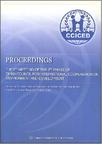第三届中国环境与发展国际合作委员会第二次会议文件汇编
2004-7
中国环境科学出版社
中国环境与发展国际合作委员会
385
《第三届中国环境与发展国际合作委员第二次会议文件汇编(英文版)》内容为:温家宝会见第三届中国环境与发展国际合作委员会第二次会议代表 新华社北京10月31日电(记者袁晔) 国务院总理温家宝31日在人民大会堂会见了第三届中国环境与发展国际合作委员会第二次会议代表。
Remarks of Leaders Premier Wen Jiabao's Remarks during His Meeting with Participants of the 2nd Meeting of the 3rd Phase of CCICED Closing Speech at the 2nd Meeting of CCICED Phase III Zeng Peiyan,Vice Premier Opening Speech at the 2nd Meeting of CCICED Phase III Xie Zhenhua,Executive Vice-Chairman Opening Speech at the 2nd Meeting of CCICED Phase III Paul Thibault,Executive Vice-Chairman Opening Speech at the 2nd Meeting of CCICED Phase III Liu Jiu Jiang,Vice-Chairman Opening Speech at the 2nd Meeting of CCICED Phase III Qu Geping,Vice-Chairman Opening Speech at the 2nd Meeting of CCICED Phase III Mans Lonnroth,Vice-Chairman Summary Speech at the Closing Ceremony of the 2nd Meeting of CCICED Phase III Xie Zhenhua,Executive Vice-ChairmanMeeting Documents Recommendations of CCICED to the Government of China Minutes of the 2nd Meeting of CCICED Phase III Work Report of CCICED A Summary of Responses by Various Departments of the State Council to the Recommendations the 1st Meeting of the 3rd Phase of CCICED Report on Finances Summary Record of the 2nd Meeting of the 3rd Phase of CCICEDKeynote SpeechesIssues PaperSpecial Guests SpeechesReports of Task ForcesName List
2.2 The problem of low investment efficiencyDue to the growing demand for financing, and despite inefficiencies nationwide, China hasstarted to introduce market-based approaches for pollution prevention and control. The lowefficiency of environmental investment in China is mainly reflected by inefficiencies andproblems in the construction, operation, and management of urban wastewater treatment andsolid waste disposal facilities as well as in industrial pollution treatment facilities.For years, in the field of urban environmental infrastructure, the government has been the mainsource of funding for construction of these facilities, with non-profit organizations5 responsiblefor their operation and management. This type of government monopoly excludes institutional competition, which in turn contributes to the problem of low investment efficiency. In this regard,similar situations have occurred in the past in developed countries and in some cases still exist.But the problems formed under the planned economy are especially complicated and severe. Inindustrial pollution control, China implemented a single basic policy that states that the polluteris the one responsible for treatment, and, subsequently, all polluting enterprises built andoperated their own treatment facilities. Little consideration was given to leaving pollution treatment to specialized enterprises through a levy mechanism, which could bring about efficiencies in the division of labor and economies-of-scale into full play. Because of this,implementation of the "polluter treats pollution" policy caused investment inefficiencies for SMEs. The emergence of this situation in China was clearly associated with the development process of the environment-related service sector.With the advancing reforms of the market economy system and the ongoing development of the environmental service industry, a pattern of so-called "marketization''6 emerged in China for pollution treatment at the end of the 1990s, based on international trends favoring practices suchas PPP and PFI7 In the field of urban environmental infrastructure, marke tization iscontributing to a break-up of the government's monopoly structure.
《第三届中国环境与发展国际合作委员第二次会议文件汇编(英文版)》由中国环境科学出版社出版。

第三届中国环境与发展国际合作委员会第二次会议文件汇编 PDF格式下载